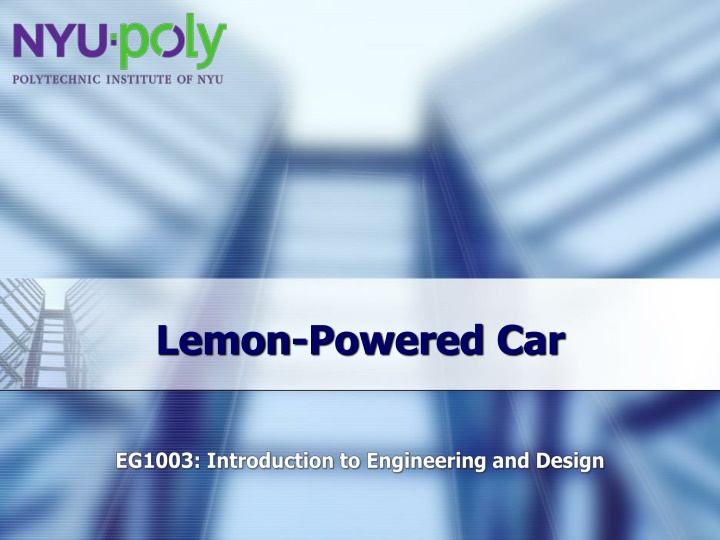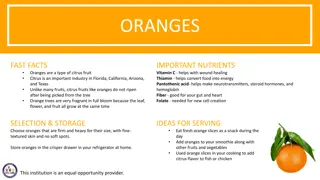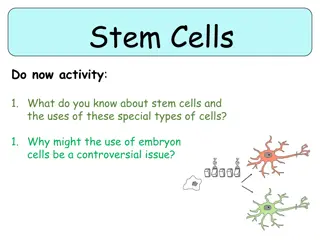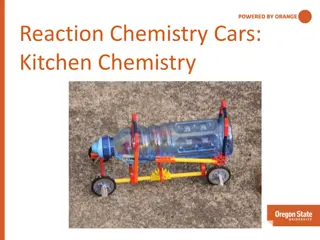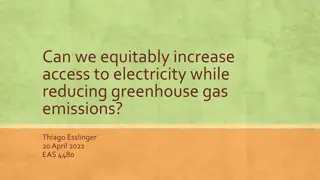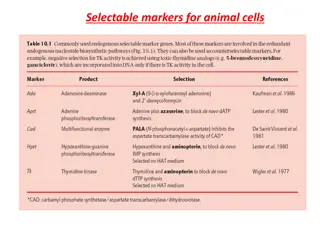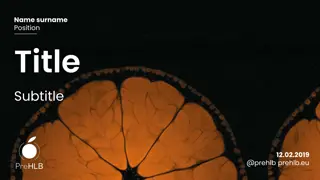Lemon-Powered Car Experiment: Creating Electricity from Citrus Cells
The Lemon-Powered Car experiment involves determining the potency of reducing agents, creating chemical cells to generate electricity, utilizing capacitors to store and release energy, and building a car powered by a chemical reaction. Key concepts covered include redox reactions, batteries, capacitors, and designing citrus cell batteries. The experiment explores fundamental ideas like electronegativity, ionization energy, and the arrangement of batteries in series and parallel circuits. Capacitor charging and the designing of citrus cells with citrus acid as an electrolyte are also discussed.
Download Presentation

Please find below an Image/Link to download the presentation.
The content on the website is provided AS IS for your information and personal use only. It may not be sold, licensed, or shared on other websites without obtaining consent from the author.If you encounter any issues during the download, it is possible that the publisher has removed the file from their server.
You are allowed to download the files provided on this website for personal or commercial use, subject to the condition that they are used lawfully. All files are the property of their respective owners.
The content on the website is provided AS IS for your information and personal use only. It may not be sold, licensed, or shared on other websites without obtaining consent from the author.
E N D
Presentation Transcript
Overview Experimental Objective Background Information Materials Procedure Assignment Conclusion
Experimental Objective Determine potency of reducing agents Create chemical cells to generate electricity Use capacitors to store/release energy Build car powered by chemical reaction
Background Information Fundamental ideas Redox (reduction/oxidation) reactions Batteries Designing citrus cell batteries Capacitors
Fundamental Ideas Electronegativity: measure of element s attractions of another s electrons Ionization energy: energy to remove electron from atom and form a cation Both properties Periodic Table Increase: left to right bottom to top
Redox Reactions When a reaction can be separated into oxidation and reduction Oxidation: electron loss ex: Mg Mg+2 + 2e- Reduction: electron gain ex: O2 + 4e- 2O-2
Batteries Battery arrangement Series circuit increases voltage Parallel circuit increases current = + + V V V V = = V V V out A B C out D E
Capacitors Store electrical energy 1F (Farad) Polarized Capacitor Positive Negative
Capacitor Charging Capacitor charge limit is restricted by charge voltage Maximizing applied voltage maximizes energy stored Capacitor is charged in time increments called the time constant (tau): =RC R=resistance C=capacitance
Percentage Charged Charge is logarithmic It takes approximately 4 to charge the capacitor Ex:
Designing of Citrus Cells A citrus cell/battery Uses two different electrodes Citrus acid used as electrolyte
Electrolytic Solutions Non-metallic part of circuit Electrolytes dissociate free ions to create an electrically conductive solution Lemon Juice used as electrolyte
Materials Lemons Lemon Juice Magnesium Copper Zinc Nickel Aluminum 3 Alligator Cable Sets 1 Farad 2.5v Capacitor Standard Lego Car Chassis Lego to Alligator Cable Clip Connector Light Emitting Diode(LED) Small Cups Scissors Tape DMM (Digital Multi Meter) Large Plates
Procedure Part 1 Determine voltage potential of electrodes Determine positive and negative poles Part 2 Light up LED using two lemon cells with most potent electrode pairs Part 3 Decide on the power source Chemical cell or capacitor Design/Build your car to accept power source
Procedure Part 1 Acquire Materials Squeeze/roll lemon Insert electrodes into lemon cm from each other Connect electrodes to DMM Record Voltage Determine polarity of lemon cell
Procedure Part 2 Create second citrus cell Connect two citrus cells in series Attach to LED Is it lit?
Procedure Part 3 Choose your electrodes (remember cost) Design your power source Chemical or capacitor Design car for power source Allow 15 min for capacitor to charge Create a sketch/pricelist TA must sign your work Enter competition
Competition Factors that will effect the CR (Competition Ratio) are: Distance traveled in 60 seconds Cost of components . 100 Cost Dist + = + * . CR Dist 1 ( 60 ) Cost List Item Cost Capacitor $1.00 2oz Lemon Juice (with cup) $0.25 1.5" Mg Strips $1.00 Cu Strip $0.25 Zn Strip $0.50 Al Strip $0.25 Ni Strip $0.25 Lemon Car Components $0.00
Assignment: Report Team report Title page Discussion topics in the manual Include original data with instructor s initials Scan in data and lab notes (ask TA for assistance)
Assignment: Presentation Team presentation Include photos of the lemon car Explain how the battery works
Conclusion Return all electrodes to TA Have return signed Clean up all materials TAs will tabulate competition results Extra credit awarded according to manual
